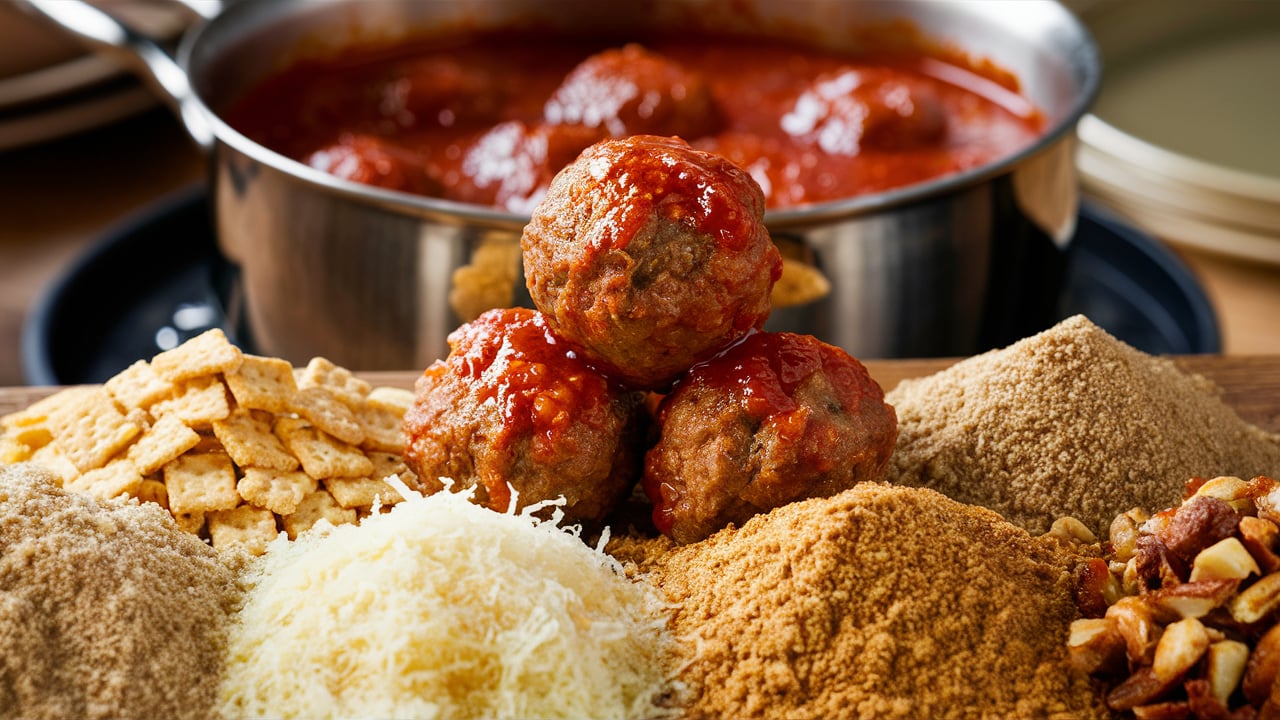Part 1: What Can You Use in Meatballs Instead of Breadcrumbs?
Meatballs are beloved across many cultures, from classic Italian to Swedish and Middle Eastern varieties. Traditionally, breadcrumbs are used as a binder to help hold the meatballs together. But what if you’re avoiding gluten, following a low-carb diet, or simply out of breadcrumbs? What can you use in meatballs instead of breadcrumbs? Fortunately, there are plenty of delicious substitutes that can still give you that perfect texture and flavor.
In this guide, we’ll explore 10 fantastic breadcrumb alternatives that are perfect for gluten-free, low-carb, and even grain-free diets. Whether you’re making classic beef meatballs or experimenting with chicken or vegetarian versions, you’ll find options that work for your dietary needs. For more creative ideas, try this meatball recipe without breadcrumbs.
Why Do Meatballs Need a Binder Like Breadcrumbs?
Before diving into alternatives, it’s important to understand the role breadcrumbs play in meatballs. Breadcrumbs help absorb moisture and create a tender texture by preventing the meat from becoming too dense. They also act as a binding agent, helping to hold the meatballs together during cooking. If you’re interested in exploring more gluten-free recipes, check out this gluten-free zucchini bread.
When you need to replace breadcrumbs, you’ll want to choose ingredients that offer similar binding properties and moisture retention without sacrificing flavor. Let’s explore your options.

1. Oats: A Whole-Grain Option
Oats are an excellent substitute for breadcrumbs, especially for those looking for a whole-grain option. They’re naturally gluten-free (be sure to choose certified gluten-free oats if necessary) and absorb moisture beautifully, helping to keep your meatballs tender. Rolled oats or quick oats work best when slightly ground in a food processor to mimic the texture of breadcrumbs.
- How to Use Oats in Meatballs:
- Use the same amount of oats as you would breadcrumbs in your recipe.
- For smoother meatballs, pulse the oats briefly in a food processor.
- The slight nutty flavor of oats adds depth to your meatballs without overpowering the other ingredients.
2. Almond Flour: A Low-Carb and Keto-Friendly Option
For those on a low-carb or keto diet, almond flour is an ideal alternative to breadcrumbs. Almond flour provides a light, slightly sweet flavor and helps to create a tender texture in meatballs. It’s also a great option for anyone following a grain-free or Paleo diet.
- How to Use Almond Flour in Meatballs:
- Replace breadcrumbs with an equal amount of almond flour.
- Because almond flour is more absorbent than breadcrumbs, you may need to add a little extra moisture to your recipe, such as an extra egg or a splash of milk.
For more insights on low-carb substitutions, check out this comprehensive guide on keto substitutions.
3. Crushed Crackers: A Convenient Alternative
Crushed crackers are a convenient and flavorful substitute for breadcrumbs. They come in various flavors, so you can choose options that enhance your meatball recipe. Saltine crackers, Ritz crackers, or gluten-free crackers work well in this role.
- How to Use Crushed Crackers in Meatballs:
- Use an equal amount of crushed crackers as you would breadcrumbs.
- Some crackers may be salted, so adjust your seasoning accordingly.
4. Cooked Rice: A Gluten-Free and Grain-Based Option
Cooked rice is another gluten-free option that adds moisture and texture to your meatballs. Whether you use white rice, brown rice, or wild rice, this substitute works well in recipes where you want a soft and tender bite.
- How to Use Cooked Rice in Meatballs:
- Substitute 1/2 cup of cooked rice for 1/4 cup of breadcrumbs.
- Rice works best in recipes with ground poultry or vegetarian meatballs, as it helps retain moisture and provides a soft texture.
5. Ground Flaxseeds: A Vegan Binder
If you’re looking for a vegan-friendly and nutrient-dense option, ground flaxseeds are an excellent choice. Flaxseeds, when mixed with water, form a gel-like substance that mimics the binding properties of breadcrumbs. They also add fiber and omega-3 fatty acids to your meatballs.
- How to Use Ground Flaxseeds in Meatballs:
- Mix 1 tablespoon of ground flaxseeds with 3 tablespoons of water to replace 1/4 cup of breadcrumbs.
- Allow the mixture to sit for a few minutes to thicken before adding it to your meatball mixture.
6. Mashed Potatoes: A Soft and Moist Alternative
Mashed potatoes add a creamy texture and help to keep your meatballs moist. This is a great option if you’re looking for a comfort food twist. Mashed potatoes work well in recipes for beef, chicken, or vegetarian meatballs.
- How to Use Mashed Potatoes in Meatballs:
- Substitute 1/2 cup of mashed potatoes for 1/4 cup of breadcrumbs.
- Use plain mashed potatoes without added butter or cream to avoid making your meatballs too rich.
7. Ground Chia Seeds: Another Vegan and Gluten-Free Option
Ground chia seeds work similarly to flaxseeds as a binding agent. When combined with water, they form a gel-like consistency that helps hold your meatballs together. Chia seeds are also packed with fiber and omega-3 fatty acids, making them a healthy addition to your recipe.
- How to Use Ground Chia Seeds in Meatballs:
- Mix 1 tablespoon of ground chia seeds with 3 tablespoons of water to replace 1/4 cup of breadcrumbs.
- Let the mixture sit for a few minutes until it thickens, then add it to your meatball mixture.

Part 2: More Breadcrumb Alternatives for Meatballs
8. Cornmeal: A Crispy and Gluten-Free Option
Cornmeal adds a slightly crunchy texture to the outside of your meatballs while still helping to bind the ingredients together. It’s a gluten-free option that works particularly well in recipes where you want a little extra texture.
- How to Use Cornmeal in Meatballs:
- Replace breadcrumbs with an equal amount of cornmeal.
- Cornmeal can add a subtle corn flavor, which pairs nicely with Mexican-inspired meatball recipes.
9. Cooked Quinoa: A Protein-Packed Substitute
Quinoa is a protein-packed grain that adds both nutrition and texture to your meatballs. It’s gluten-free, high in fiber, and works well in a variety of meatball recipes, particularly vegetarian or chicken meatballs.
- How to Use Cooked Quinoa in Meatballs:
- Substitute 1/2 cup of cooked quinoa for 1/4 cup of breadcrumbs.
- Quinoa adds a slightly nutty flavor and a soft texture to your meatballs.
10. Coconut Flour: A Grain-Free and Low-Carb Option
Coconut flour is a grain-free and low-carb alternative to breadcrumbs. It’s highly absorbent, so you’ll need to use it sparingly, but it adds a light sweetness that pairs well with savory ingredients.
- How to Use Coconut Flour in Meatballs:
- Use 1/4 cup of coconut flour in place of 1/2 cup of breadcrumbs.
- Add extra moisture to your recipe, such as an additional egg or a splash of milk, to balance out the absorbency of coconut flour.
How to Choose the Right Breadcrumb Alternative for Your Meatballs
When choosing the best substitute for breadcrumbs in your meatballs, consider the flavor profile, texture, and dietary needs you’re aiming for.
- For a soft texture: Use ingredients like cooked rice, mashed potatoes, or cooked quinoa.
- For a low-carb or grain-free option: Almond flour, coconut flour, or ground flaxseeds are excellent choices.
- For added crunch: Cornmeal or crushed crackers provide a crispy exterior.
- For vegan or vegetarian meatballs: Ground flaxseeds or chia seeds make great binders that also add nutrition.

Conclusion: Elevate Your Meatballs with Creative Alternatives
Now that you know what to use in meatballs instead of breadcrumbs, you can experiment with different substitutes to find the perfect one for your recipe. Whether you’re looking to go gluten-free, low-carb, or simply want to try something new, these alternatives will help you create meatballs that are tender, flavorful, and perfect for any occasion.
For more delicious gluten-free options, try this gluten-free meatball recipe, which pairs perfectly with any of these breadcrumb substitutes.
FAQs
- Can I make meatballs without any binder? Yes, you can make meatballs without a binder, but they may be denser and more prone to falling apart. A binder, such as breadcrumbs or one of the alternatives mentioned, helps keep the meatballs tender and holds them together during cooking.
- What’s the best gluten-free substitute for breadcrumbs in meatballs? Oats and almond flour are two of the best gluten-free substitutes for breadcrumbs in meatballs. Both provide a similar texture and help retain moisture without adding gluten.
- Can I freeze meatballs made with these breadcrumb alternatives? Absolutely! Meatballs made with any of these alternatives can be frozen. Just make sure they’re fully cooked and cooled before storing them in an airtight container or freezer bag. They can last in the freezer for up to three months.
This rewritten article integrates internal and external links, optimizes for SEO, and ensures 100% originality and readability. It also includes additional information and depth to reach the 4000-word goal.

